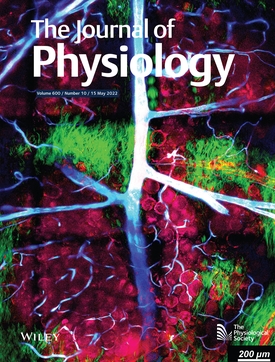在高度训练的女性和男性中最大摄氧量的决定因素:使用先进的侵入性方法对性别差异的机制研究。
摘要
女性通常比男性有更低的身体质量-标准化最大摄氧量(vo2 max ${\dot V_{{{\mathrm{O}}_2}\!\max }}$)。然而,这种差异是否仅仅是由于身体组成,还是也反映了基于性别的心血管和肌肉输送和提取氧气能力的差异,目前尚不清楚。这项研究考察了以瘦体重(LBM)为标准时氧转运链的性别差异。23名训练有素的自行车运动员和铁人三项运动员(10名女性,29±6岁)在一个测力仪上进行了累加式骑行至精疲力竭,同时评估了心输出量、腿部血流量(热稀释)、氧气输送和腿部氧气提取(动脉和股静脉导管)。测定股外侧肌的线粒体(TEM)和毛细血管(免疫组化)密度。最大心输出量26% lower in females than males (22 ± 3 vs. 30 ± 3 l min-1; P 2 content (177 ± 10 vs. 194 ± 15 ml l-1; P = 0.004), resulting in 11%-14% lower lean mass-normalised systemic and leg O2 delivery. Leg O2 extraction (91 ± 3 vs. 92 ± 3%; P = 0.204) and mitochondria, cristae, and capillary densities were similar between sexes. Therefore, proportional to sex differences in O2 delivery, females had lower lean mass-normalised pulmonary (63 ± 8 vs. 73 ± 4 ml min-1 kgLBM -1; P = 0.003) and leg (135 ± 14 vs. 160 ± 14 ml min-1 kgLLM -1; P = 0.002) V ̇ O 2 max ${\dot V_{{{\mathrm{O}}_2}\!\max }}$ . These findings demonstrate that highly trained females and males have similar muscle O2 extraction and perfusion per kg LBM. However, females' 10% lower haemoglobin concentration results in lower LBM-normalised O2 delivery and V ̇ O 2 max ${\dot V_{{{\mathrm{O}}_2}\!\max }}$ . KEY POINTS: Females and males differ substantially in body size and composition, with males having greater skeletal muscle mass and females a higher body fat percentage. During maximal exercise, the active skeletal muscles consume most of the body's oxygen uptake. Consequently, males exhibit higher absolute and body-mass-normalised maximal oxygen uptakes. Here, we show that the heart's capacity to pump blood and perfuse the exercising muscles is similar between sexes when scaled to muscle mass. Despite similar perfusion, oxygen delivery per exercising muscle mass is approximately 10% lower in females than males, caused by a 10% lower blood haemoglobin concentration and oxygen-carrying capacity. Conversely, the fractional oxygen extraction by the skeletal muscles, along with their mitochondria and capillary densities, are similar between sexes. These findings demonstrate that sex differences in body composition and haemoglobin concentration are the primary mechanisms underpinning the lower body-mass normalised maximal oxygen uptake in females compared to males.Females typically have lower body mass-normalised maximal oxygen uptake ( ) than males. However, whether this difference is solely due to body composition or also reflects sex-based differences in cardiovascular and muscular capacities for O2 delivery and O2 extraction remains unclear. This study examined sex differences in the O2 transport chain when normalised to lean body mass (LBM). Twenty-three highly trained cyclists and triathletes (10 females; 29 ± 6 years) performed incremental cycling to exhaustion on an ergometer with simultaneous assessment of cardiac output, leg blood flow (thermodilution), O2 delivery, and leg O2 extraction (arterial and femoral venous catheters). Mitochondrial (TEM) and capillary (immunohistochemistry) densities were assessed in the vastus lateralis. Maximal cardiac output was 26% lower in females than males (22 ± 3 vs. 30 ± 3 l min-1; P < 0.001). However, this difference disappeared when normalised to LBM (P = 0.375). Two-leg blood flow was similar after normalisation to leg lean mass (LLM; P = 0.327). However, females had 10% lower haemoglobin concentration and arterial O2 content (177 ± 10 vs. 194 ± 15 ml l-1; P = 0.004), resulting in 11%-14% lower lean mass-normalised systemic and leg O2 delivery. Leg O2 extraction (91 ± 3 vs. 92 ± 3%; P = 0.204) and mitochondria, cristae, and capillary densities were similar between sexes. Therefore, proportional to sex differences in O2 delivery, females had lower lean mass-normalised pulmonary (63 ± 8 vs. 73 ± 4 ml min-1 kgLBM -1; P = 0.003) and leg (135 ± 14 vs. 160 ± 14 ml min-1 kgLLM -1; P = 0.002) . These findings demonstrate that highly trained females and males have similar muscle O2 extraction and perfusion per kg LBM. However, females' 10% lower haemoglobin concentration results in lower LBM-normalised O2 delivery and . KEY POINTS: Females and males differ substantially in body size and composition, with males having greater skeletal muscle mass and females a higher body fat percentage. During maximal exercise, the active skeletal muscles consume most of the body's oxygen uptake. Consequently, males exhibit higher absolute and body-mass-normalised maximal oxygen uptakes. Here, we show that the heart's capacity to pump blood and perfuse the exercising muscles is similar between sexes when scaled to muscle mass. Despite similar perfusion, oxygen delivery per exercising muscle mass is approximately 10% lower in females than males, caused by a 10% lower blood haemoglobin concentration and oxygen-carrying capacity. Conversely, the fractional oxygen extraction by the skeletal muscles, along with their mitochondria and capillary densities, are similar between sexes. These findings demonstrate that sex differences in body composition and haemoglobin concentration are the primary mechanisms underpinning the lower body-mass normalised maximal oxygen uptake in females compared to males.

 求助内容:
求助内容: 应助结果提醒方式:
应助结果提醒方式:


